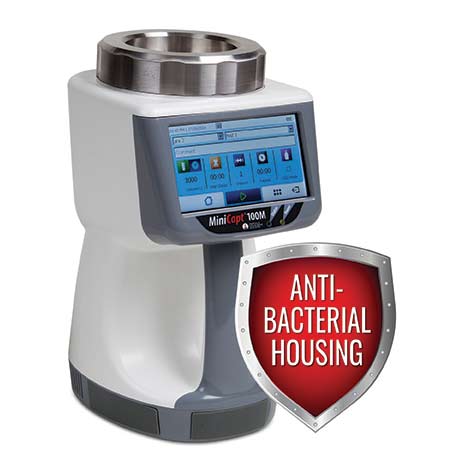What Is GPT?
The Growth Promotion Test (GPT) determines the appropriateness of the culture media to be used in environmental monitoring sampling. The medium is challenged with a small number of microorganisms to assure the nutritive properties, functionality and media quality are adequate for the detection and enumeration of microbial contaminants.
The test is described in the following documents:
- USP Chapter <61>, Microbiological Examination of Nonsterile Products: Microbial Enumeration Tests
- USP Chapter <62>, Microbiological Examination of Nonsterile Products: Tests for Specified Substances
- USP Chapter <71>, Sterility Test
- European Pharmacopoeia chapters 2.6.12, 2.6.13, and 2.6.1
The test may be run on solid media and in broths according to the European and United States Pharmacopoeias. GPT is performed by inoculating the product with ≤ 100 CFU of microorganisms, defined by the pharmacopoeia. The test can be quantitative, at which 50 – 200% of the inoculated microorganisms should be recovered after incubation of the media, or it can be qualitative, where the requirement is “growth” or “no growth”.
It is important to stress that the GPT must be tested for each new batch of medium. Growth promotion must be checked on agar media and nutritive broth but not on diluted broth.
Procedure
The procedure to follow is summarized below:
- The new medium is inoculated with 100 or less CFU of microorganisms.
- The microorganisms recommended by the pharmacopeia are used in the test. Microorganisms must be no more than 5 passages removed from the original reference culture seed lot.
- After incubation, growth on the new batch of medium is compared to growth on the previously approved batch of medium.
The acceptance criteria for this test as described in USP Chapter <61> is:
“If testing agar, the number of colonies on the new batch of medium must be within a factor of two of the number of colonies on the previously approved medium. If testing broth, the new and previously approved medium must be comparable in appearance.”
It is important to clarify that a factor of two means the number of colonies on the new agar must be no more than twice and no less than half the number of colonies on the previously approved agar. For example, if the number of colonies on the previously approved agar is 30, then the acceptable number of colonies on the new agar should be in the range of 15 to 60.
Remember…
To ensure a successful GPT, adhere to the following recommendations:
- Test the new medium and the previously approved medium side by side.
- When testing selective medium, test non-selective medium in parallel.
- Use a spreader to spread the inoculum so that cells do not stick together.
- Use a vortex mixer to mix the suspension after delivering each inoculum.
Recommended Microorganisms
Microorganism |
Growth Promotion (Aerobic) |
|
Total Aerobic Microbial Count |
Total Yeasts and Molds Count |
|
| Staphylococcus aureus ATCC 6538 *^ | Soybean–Casein Digest Agar and Broth, 30 –35 , 3 days | |
| Pseudomonas aeruginosa ATCC 9027 ~ | Soybean–Casein Digest Agar and Broth, 30 –35 , 3 days | |
| Bacillus subtilis ATCC 6633 | Soybean–Casein Digest Agar and Broth, 30 –35 , 3 days | |
| Candida albicans ATCC 10231 | Soybean–Casein Digest Agar and Broth, 30 –35 , 5 days | Sabouraud Dextrose Agar
20 –25 , 5 days |
| Aspergillus brasiliensis ATCC 16404 | Soybean–Casein Digest Agar and Broth, 30 –35 , 5 days | Sabouraud Dextrose Agar
20 –25 , 5 days |
Monitoring Anaerobes
Anaerobic environmental monitoring is not a routine process but is occasionally performed to detect potential anaerobic microbial contaminants, particularly those related to contamination by personnel.
For practical purposes, there are three categories of anaerobe:
- Obligate, which are harmed by the presence of oxygen.
- Aerotolerant, which cannot use oxygen for growth, but tolerate its presence.
- Facultative, which can grow without oxygen but use oxygen if it is present.
Suggested anaerobic control strains:
- Propionibacterium acnes ATCC 11827 or 6919 (gram-positive, aerotolerant anaerobic)
- Clostridium sporogenes ATCC 19404 or 11437 (gram-positive, obligate anaerobic)*
- Bacteroides fragilis ATCC 25285 (gram-negative, obligate anaerobic, rod shaped bacterium. It is part of the normal flora of the human colon and is generally commensal)
Agar Plates
Regular microbiological plates or contact plates may be used for the GPT of anaerobes. They may contain either Tryptic Soy Agar (TSA) or Sabouraud Dextrose Agar (SDA), and be supplemented with neutralizers of a wide range of disinfectants, or β-lactam antibiotics for monitoring sanitized, dry surfaces. Neutralizers such as lecithin (L), Tween® 80 (T), histidine (H) and sodium thiosulfate (Th) are able to inactivate residues of disinfectants, a wide range of which are used the world over for disinfection. TSA plates can be safely incubated in the range of 30 °C to 37 °C for these anaerobes.
Learn more… Get the full paper here.



